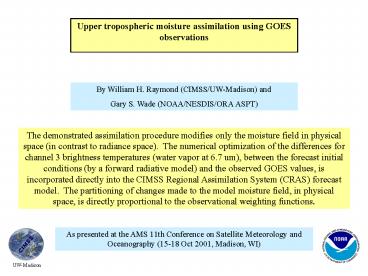Upper tropospheric moisture assimilation using GOES observations - PowerPoint PPT Presentation
Title:
Upper tropospheric moisture assimilation using GOES observations
Description:
channel 3 brightness temperatures. Form weighted sum. for q or RH using ... UTC runs during the 10 day period, the average improvement in correlation was 12 ... – PowerPoint PPT presentation
Number of Views:17
Avg rating:3.0/5.0
Title: Upper tropospheric moisture assimilation using GOES observations
1
Upper tropospheric moisture assimilation using
GOES observations
By William H. Raymond (CIMSS/UW-Madison) and Gary
S. Wade (NOAA/NESDIS/ORA ASPT)
The demonstrated assimilation procedure modifies
only the moisture field in physical space (in
contrast to radiance space). The numerical
optimization of the differences for channel 3
brightness temperatures (water vapor at 6.7 um),
between the forecast initial conditions (by a
forward radiative model) and the observed GOES
values, is incorporated directly into the CIMSS
Regional Assimilation System (CRAS) forecast
model. The partitioning of changes made to the
model moisture field, in physical space, is
directly proportional to the observational
weighting functions.
As presented at the AMS 11th Conference on
Satellite Meteorology and Oceanography (15-18 Oct
2001, Madison, WI)
UW-Madison
2
For modification of the model initial moisture
field by GOES channel 3 (6.7 um)
Model initial field Mixing ratio (q) Relative
humidity (RH)
Goal - minimize difference
Forward radiative transfer model
Model equivalent brightness temperature
Satellite observed brightness temperature
Difference field for channel 3 brightness
temperatures
Form weighted sum for q or RH using satellite
weighting function
Redistribute perturbation using weighting
functions
Modify sum using numerical techniques
3
Adjustment of the 6.7 um water vapor field in the
model
(0000 UTC 15 Sep 2000)
Initial eta field in CRAS model
GOES observations (Ch 3) using recursive filter
1.
2.
Eta model field modified by assimilation of GOES
observations
4
Inclusion of GOES channel 3 brightness
temperature in the model assimilation improves
correlation of model synthetic images compared to
observed images
For these 00 UTC runs during the 10 day period,
the average improvement in correlation was 12.
5
Inclusion of GOES channel 3 brightness
temperature in the model assimilation improves
correlation of model synthetic images compared to
observed images
Even through 48 hour forecasts, the correlation
was generally improved (2.3).
6
MODETA.GIF (model initial modified eta)
7
OBSFILT.GIF (GOES observations - recursive
filter)
8
CRASINIT.GIF (GOES data were used to modify eta)































